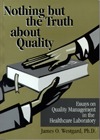Basic QC Practices
Repeated, Repeated, Got Lucky!
Believe it or not, this is an actual comment from an QC action log (from a facility that shall remain nameless). At least the author was being honest about how he/she was performing their QC - by luck, not by science. If you still use 2s limits for your controls, you need to read this article. If you still repeat controls and runs until they're "in," you need to read this article. And for anyone who thinks that QC is just fine, you really, really need to read this article. (Preview)
July 2001
The title of this essay comes from a story about the review of laboratory quality control records. The story was told by a participant at our recent workshop on Six Sigma Quality Management. In auditing the QC records of a laboratory, the response to an out-of-control situation was documented as "Repeated, repeated, got lucky!"
This phrase captures a QC practice that is common in many laboratories - repeat the control until it finally falls within the limits. In the instance cited, this particular analyst was honest enough to know that nothing had changed with the quality of the testing process except, luckily, the control finally fell within acceptable limits. No one knows what was going on with the patient samples?
What's wrong?
It seems silly to run controls to check the quality of laboratory tests, then almost automatically disregard the results when they indicate something might be wrong! Yet that is exactly what is being done in many laboratories today.
Here's a common protocol that describes how laboratories respond to control results:
- If in, report patient results.
- If out of control, repeat the control; if in this time, report patient results.
- If out of control, prepare a new control and analyze it; if in this time, report patient results.
- If out of control, repeat the new control; if in, report patient results.
- If still out of control, do something to fix the problem.
If out of luck after four repeats, then something needs to be done to fix the testing process. Repeat, repeat, repeat, repeat - no luck, fix problem! As you might imagine, some laboratories have more sophisticated protocols and come up with an even high number of repeats!
Don't use 2 SD control limits! The real culprit that has compromised laboratory QC is the use of 2 SD control limits, which give a high level of false rejections - 5% for 1 measurement on 1 material (N=1), 9% for 1 measurement on each of 2 materials (N=2), 14% for 1 measurement on each of 3 materials (N=3). Experience with false rejections or false alarms compromises the detection system. Think about a fire alarm and the effect of hearing false alarms. After one or two false alarms, no one pays any attention to the alarm system.
Don't calculate control limits from labeled means and SDs. One way to get rid of these false alarms is to make the control limits wider. Laboratories have come up with all kinds of rationalizations to do this. One common practice is to use the labeled or bottle values provided by manufacturers. Those bottle values represent the performance observed for several methods or instrument in several different laboratories. They include between laboratory differences that make the SDs larger than what would be observed in a single laboratory. Larger SDs, larger control limits, fewer false rejections, also less error detection. How much less? Who knows?
 We invite you to read the rest of this article
We invite you to read the rest of this article
This complete article and many more essays are available in the Nothing but the Truth about Quality manual. You can also download the Table of Contents and additional chapters here.
